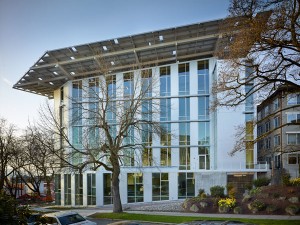
LEED has been the sustainability standard for federal construction and renovation since 2003, but as discussed in an earlier post, the GSA is currently reviewing competing green building certification systems as required by law. Many assume that industry-friendly Green Globes is the only viable alternative, but the greenest horse in the race, behind but cheered on by devoted fans, is the performance-based Living Building Challenge (LBC).
Created in 2006 by a Seattle-based non-profit, LBC styles itself “a philosophy, advocacy tool, and certification program.” Projects, whether new construction or renovation, can be certified only after proving achievement of energy, water and waste efficiency goals. Theoretically, LEED or Green Globes buildings could receive certification at ribbon-cutting ceremonies (if the paperwork is done), but LBC facilities must first monitor resource use and occupant behavior. Twelve months of solid data are required for a chance to earn “Living” status, LBC’s equivalent of LEED-Platinum or four Green Globes.
From its inception, LBC has been developed to be more rigorous than LEED or BREEAM (the UK-originating certification system behind Green Globes). In the current version, seven performance areas, called “Petals,” are addressed for all scales of projects: Site, Water, Energy, Health, Materials, Equity and Beauty. Petals are further subdivided into a total of 20 imperatives for developers to satisfy, though LBC does not mandate how performance goals must be achieved. Imperatives such as “beauty and spirit” may be best left to designers’ creativity, but LBC offers some guidance. Notably, a “Red List” is provided for the Materials Petal, indicating materials and chemicals to limit or avoid such as mercury, phthalates and PVC. With imperatives of net zero energy, net zero water, and other beyond-LEED standards, only six buildings had qualified as “Living” as of spring 2013.
A 2012 study by the GSA compared LEED, Green Globes and LBC to federal requirements. LEED was found to address the highest number of federal priorities for existing buildings (27 out of 28 mandates), while Green Globes aligned better for new construction (25 out of 27 requirements). LBC did less well than either competitor in both cases, only partially aligning with some requirements and missing others altogether. Limited alignment is not surprising, given LBC’s lofty sustainability aspirations, and it remains under consideration by the GSA.
For critics, ambitious standards—and the high costs to meet them—disqualify LBC as a realistic choice. Not so for the Bullitt Foundation, which sought an environmentally progressive headquarters to match its organizational mission. Opened on Earth Day 2013, the 6-floor, 50,000-square-foot Bullitt Center may be the world’s greenest commercial building. As required for “Living” building aspirants, a monitor in the lobby displays energy conservation successes of high-efficiency rooftop photovoltaics, ground source heat pump and sensor-controlled window ventilation and shading. Performance depends on human behavior change as well as building design. Tenants, which occupy half the space, live within a strict energy budget, and electric use is monitored at the socket level. Tucked away-elevators also discourage electricity consumption. Instead, a central staircase beckons, with views of Puget Sound designed to make climbing irresistible.
The vision, challenges and construction process behind the Bullitt Center can be seen in this video. The bold sustainability targets set by LBC were daunting, admitted Chris Rogers, founding partner of Point 32, the developer behind the center. Said Rogers in a recent NPR interview, “I think it’s fair to say we were all a bit skeptical in the beginning.” But builders have been increasingly driven to incorporate green features for two decades, thanks in part to LEED- and other certificate program-inspired market shifts. The supply chain has also adapted, offering new products and services and lowering some costs. Bullitt Foundation CEO Denis Hayes justifies some of the $30 million project through its educational and inspirational value. Whether or not performance data earn it LBC “Living” status next year, Hayes told Interior Design he hopes the Bullitt Center “begins to change the way architects, engineers, contractors, developers, and financial institutions shape the built environment.”
Are we ready for federal courthouses with roof-collected drinking water and irresistible staircases? LBC certification may be too far behind LEED and Green Globes for adoption as the federal green building standard this summer. But with stamina and some racing luck, LBC’s odds could improve when the Energy Independence and Security Act of 2007 again requires certification system review in 2018.
